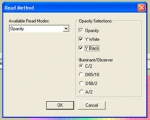
When used with industrial and commercial products, there is more than one definition of “opacity” as an optical property.
Contrast Ratio Opacity (OP) measurements quantify how close to opaque a near-opaque material is.
The measurement is a two-part program metric where the CIE Y (luminance or brightness) value is first measured the sample backed by a black background, followed by a second measurement of the Y value of the sample backed by a white background. The resulting fraction is expressed as Y%, calculated as follows:.
As Y Brightness is a colorimetric value calculated based on a CIE illuminant/’observer

condition, this must be specified and reported. The illuminant/observer choice will vary depending on the industry – A/2 (automotive), C/2 (historical and default choice), D65/2 (printing) and D65/10 (often used in current color measurements). As Opacity is a ratio, the results will be nearly identical for any of these illuminant/observer conditions.

Typical applications where contrast opacity is an important appearance characteristic are coating drawdowns and single sheets or layers of paper, plastic and textiles.
The primary appearance concern is lot-to-lot consistency in a material that is inherently not quite opaque.


